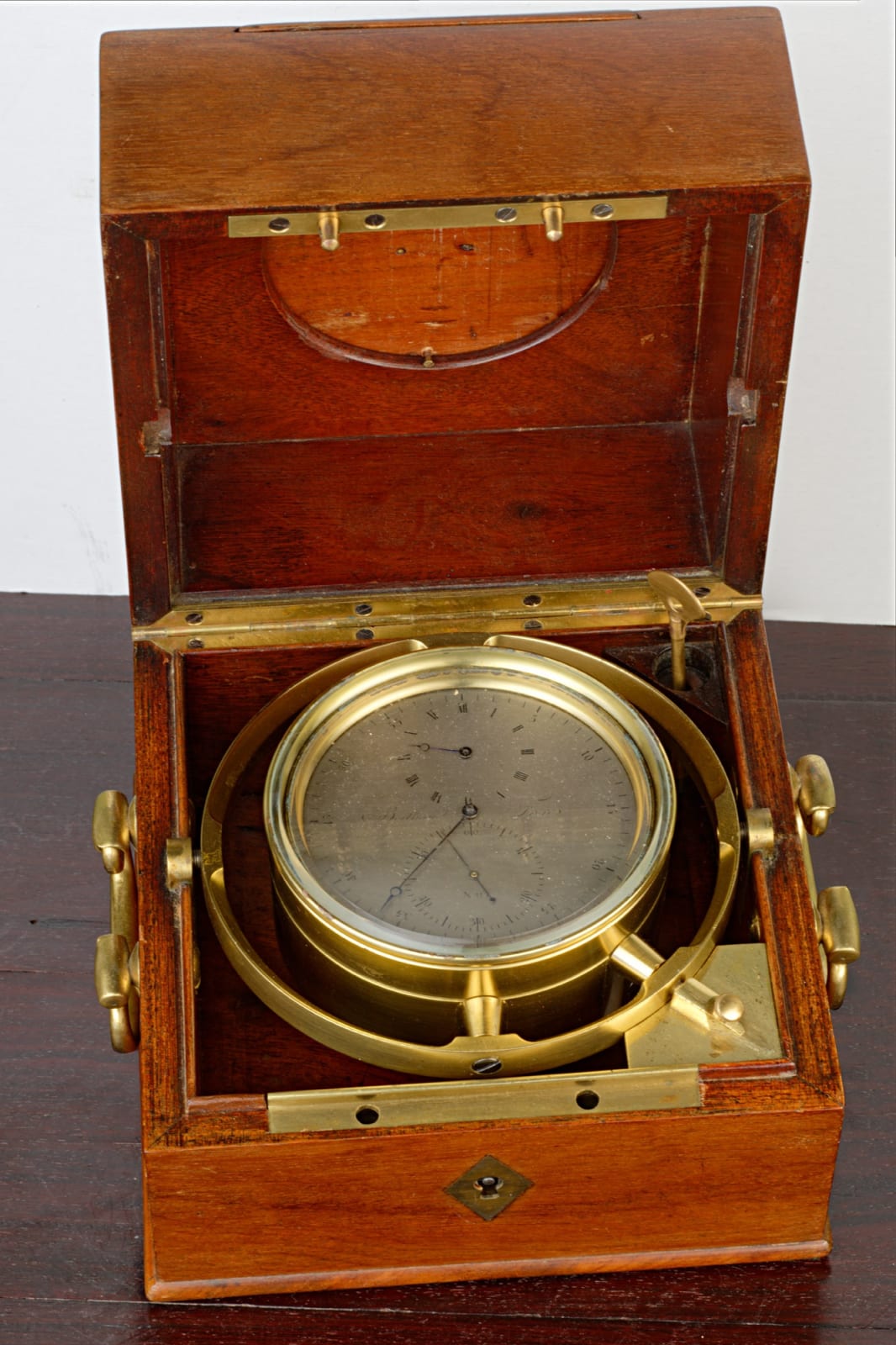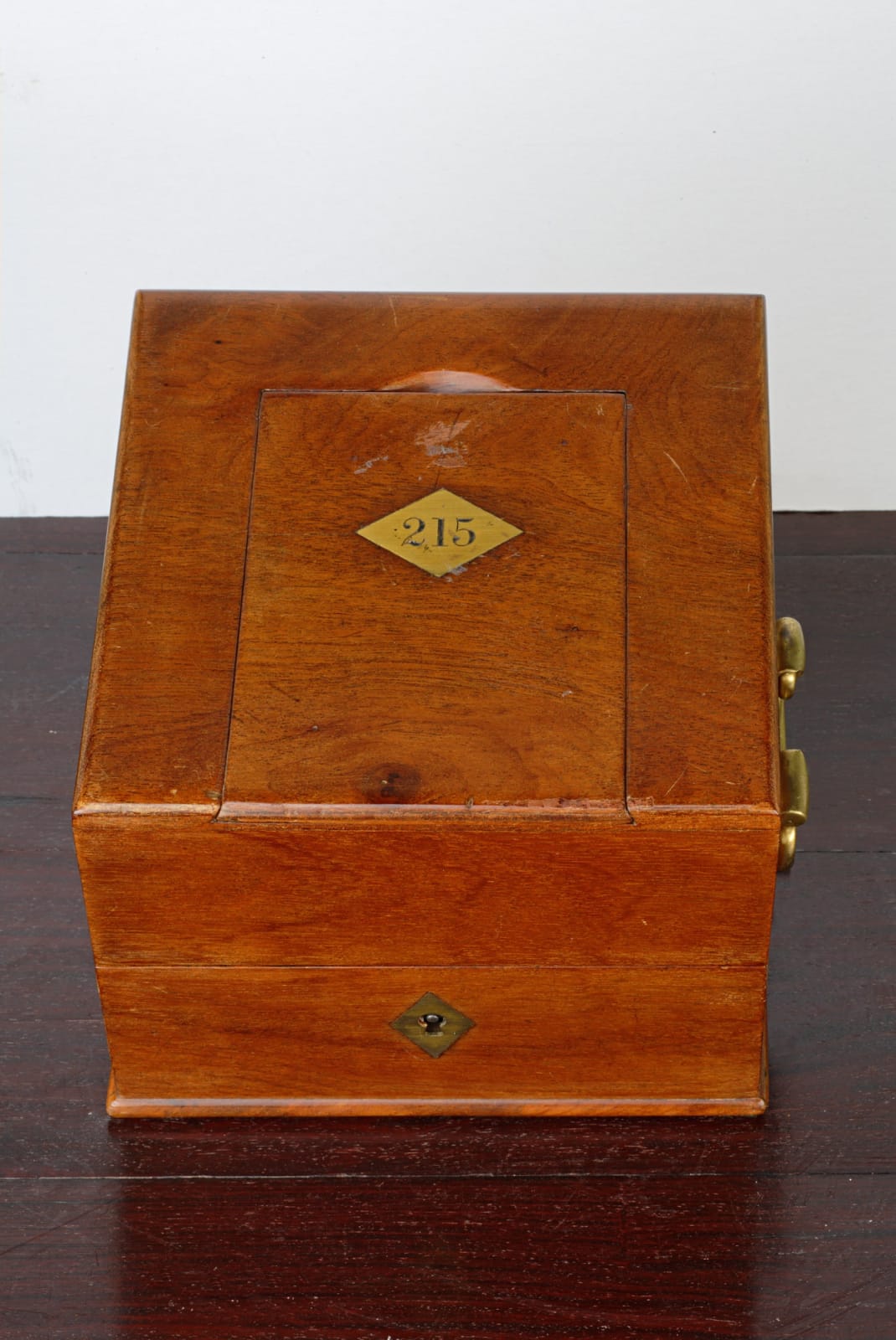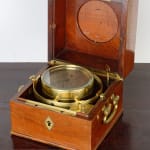Berthoud Freres
Further images
Literature
Jean-Claude Sabrier “La Longitude en Mer à l’heure de Louis Berthoud et Henri Motel”, 1993, pp. 307-309, where this marine chronometer is illustrated and described in detail.
A rare and important Louis XVIII two day marine chronometer by Berthoud Frères, signed and numbered on the silvered dial and likewise on the backplate: Berthoud Freres/N. 215. The dial with outer Arabic numerals for the five minute intervals, with a subsidiary hours dial with Roman numerals at the top and a further subsidiary seconds dial with Arabic numerals below, each dial with a Breguet-style blued steel hand. The frosted and gilt, full plate and fully jewelled movement with conical pillars secured by nuts with washers, with a chain fusee, with maintaining power, pivoted detent escapement, three armed compensation balance, with three trapezoidal weights and timing screws and blued steel conical balance spring. The brass drum cover contained within a gimballed brass outer bowl with bolt action locking arm, housed in a plain two-tier mahogany box, the top with viewing port and sliding cover with an inset diamond-shaped brass plaque numbered 215, the bottom with plinth base and double action lock and external brass handles
Argenteuil, date circa 1818
The dial: diameter 8 cm. The box: 16 x 16 x 13 cm.
Whilst this rare chronometer is identical to models made in circa 1800 by the renowned horologist Pierre-Louis, known as Louis Berthoud (1754-1813), it was in fact made in his workshop about five years after his death, when his business was being run by his two sons, namely Jean-Louis-Simon-Henri (1793-1880) and Charles-Auguste (1798-1876). Jean-Louis-Simon-Henri, better known as Louis, was born on 7th October 1793 at Argenteuil where he also died on 15th April 1880. He married Thérèse Joly, daughter of a watchcase maker on 17th April 1819 in Paris. His younger brother Charles-Auguste, who was also born at Argenteuil, on 17th November 1798, then married Thérèse Joly’s younger sister Henriette-Pauline Joly in Paris on 26th January 1822. Charles-Auguste predeceased his elder brother when he died on 15th February 1876.
Charles-Auguste Berthoud proved to be as fine a chronometer maker as his father while his elder brother’s expertise lay in retail management. Charles-Auguste was one of the youngest pupils at the Ecole d’Arts-et-Métiers, which was transferred from Compiègne to Châlons-sur-Marne in 1806. Both brothers were initially taught the art of precision horology by their father, who in turn had been the most important pupil of his illustrious uncle Ferdinand Berthoud (1727-1807). However, Louis and Charles-Auguste Berthoud’s training was cut short by their father’s sudden death in September 1813. Thus, their education was continued by their late father’s foreman Jean-François Henri Motel (1786-1859) who, on the request of Louis Berthoud’s widow, also took charge of the workshop for a short while. Following the departure of Motel, the family workshop was run by the two Berthoud brothers; trading under the name of Berthoud Frères, they continued making precision marine chronometers in the same tradition as their father. The two brothers divided the work between themselves with the elder supervising the retail outlet in Paris while Charles-Auguste directed the workshop at Argenteuil.
Like their father, the work of Berthoud Frères achieved great acclaim. They were highly praised at the Exposition des Produits de l’industrie Française in 1819 and were awarded a silver medal at the subsequent exhibitions of 1823 and 1827. Having disbanded their partnership, Charles-Auguste was awarded a gold medal at the 1834 exhibition and five years later was appointed by the Ministry of Agriculture and Trade to succeed to Louis Frédéric Perrelet as the head of a school of precision watchmaking. At the 1844 exhibition, Charles-Auguste was commended for his teaching at the school; he also received a gold medal as he again did at the 1849 exhibition when he was also named Chevalier de la Légion d’Honneur, having produced about 350 marine chronometers and a few pocket chronometers during his distinguished career.







